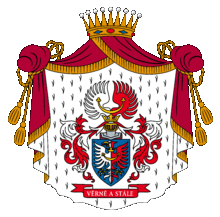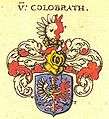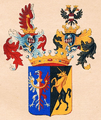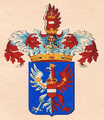Kolowrat family
| House of Kolowrat | |
|---|---|
 | |
| Country |
Bohemia Holy Roman Empire Austrian Empire Austria-Hungary |
| Titles |
Lords Imperial Counts |
| Founded | 1347: Albrecht z Kolowrat |
| Current head | Count Maximilián Alexander Kolowrat-Krakowský |
| Ethnicity | Czech |
| Cadet branches |
|
The Kolowrat family is an old and prominent Central European noble family originating in Bohemia, present-day Czech Republic. The family origins are far enough back in Bohemian history that no extant documents show them, and only a few legends from historians such as Bohuslav Balbín and František Palacký describe them.[1] They rose to prominence during the Habsburg Monarchy, during which its members held the highest of political, military, and clerical functions. Among members of the Kolowrat family we may find Minister-Presidents, Supreme Chancellors, field marshals, archbishops, and knights of the Order of the Golden Fleece.
History
Legend
The legend by historian Bohuslav Balbín tells the story of a strong man who saved a Czech king and his little son. The Czech king and his little son were travelling in a carriage when suddenly their horses started panicking. The wheel of the carriage was about to fall off, inevitably resulting in the carriage crashing. A strong man, who stood nearby, saw what was happening and grabbed the wheel of the carriage by its spokes, stopping the carriage from crashing. As thanks, the king gave the man the right to the name Kolowrat, which is a combination of the word "kolo" (wheel) and "vrátit" (to return).[2] In tribute to the above-mentioned legend, the original Kolowrat coat of arms had (still used by the city of Kolovraty) a wheel with eight spokes on the breast of the Kolowrat eagle.
Family tree
During the 14th and 15th centuries, the Kolowrat family split into eight family branches, including the Kolowrat-Krakowsky branch.
Early modern period
Another significant member of the Kolowrat-Krakowsky line was Jan Nepomuk Karel, known as Hanuš (1794–1872). The last member of the Březno branch, pure patriot and philanthropist, he supported the Matice Česká and made the largest donation to the construction of the National Theatre. Due, in no small part, to his patriotism and readiness to help people in need he inspired the character of Count Březenský in the novel The Village Under the Mountains by Božena Němcová.
Modern history
Count Leopold Filip Kolowrat-Krakowsky (1852–1910) became famous for winning the last pistol duel in Prague, in which he shot Wilhelm the hereditiary Prince of Auersperg, and was forced into exile (until later pardoned by the Emperor). The duel occurred because they were both courting Anna Countess of Waldstein. He was a member of the Imperial Council and the Czech Assembly; for his service, he received the second class Order of the Iron Crown. Apart from the Přimda estate, the Klatovy estate, and multiple Kolowrat Palaces, he also became a major shareholder of Laurin and Klement, the predecessor of Škoda Auto.
20th century
After Count Leopold Filip's death, his son Count Alexander von Kolowrat-Krakowsky (1886–1927) became the new head of the family. Alexander, called Sascha, was not only a successful car and motorcycle racing driver but also Austria's best film producer whose biggest contribution to the world’s film industry, apart from making the largest and most expensive film production in Austrian film history (Sodom and Gomorrah), was the discovery of Marlene Dietrich and Michael Curtiz. He was the owner of Sascha-Film and a good friend of Ferdinand Porsche, who built championship winning cars called Sascha Wagen for the Count. He died of cancer in 1927. In his honour there is an annual gathering of historic cars, combined with a tour around Přimda and the neighbouring towns in Bavaria. His younger brother Count Jindrich Vilem Kolowrat-Krakowsky was also an important figure in 20th century Czech history. He was known for being a successful businessman and for fighting the Nazis during their occupation of Czechoslovakia. For his courage and achievements he was awarded the Czechoslovak War Cross from president Edvard Beneš and became the ambassador to Turkey. In 1948 when still in Turkey the communists took control of Czechoslovakia and declared him an enemy of state and his estates were confiscated. Count Jindrich Kolowrat fled Turkey and settled in the United States with his family.
House of Kolowrat today
In 1989 after the Velvet Revolution, Count Jindrich Kolowrat returned to his homeland and restored his ancestral properties. He did so followed by his youngest son, Count František Tomáš, whom he made his sole heir. In 1991, president Václav Havel awarded Count Jindrich the Order of Tomáš Garrigue Masaryk (second class). Count Jindrich also rented the Kolowrat Palace for 1kc a year for the duration of 20 years to the National Theatre. He died in 1996, the same year that František Tomáš Kolowrat-Krakowsky's son Maximilian Alexander (the current head of the family) was born. Count František Tomáš died in 2004 due to lung cancer.
Important family members
- Albrecht Senior z Kolovrat (died 5 července 1391), Governor of Fojtska (Vogtlandu)
- Albrecht Krakovský z Kolovrat (died 25 května 1510), Supreme Chancellor (1503–1510)
- Emanuel Václav Krakovský z Kolovrat, Vice admiral of the Sovereign Military Order of Malta in the 18th century
- Jan Vilém Libštejnský z Kolowrat (1627–1668), Archbishop of Prague (1667–1668)
- Norbert Max Krakovský z Kolovrat (1658–1721), rakouský skutečný tajný rada, nejvyšší zemský komoří Českého království a předseda apleačního soudu v Čechách, místodržitel pražský
- Marie Anna Krakovská z Kolovrat, roz. svob. paní ze Steinu a Jettingenu, nejvyšší hofmistryně saské kurfiřtky a polské královny Marie Josefy Saské (1699–1757)
- Marie Anna Františka Krakovská z Kolovrat (1717–1762), daughter of Marie Anna, wife of rakouského předsedy vlády Jindřicha hraběte von Brühl (1700–1763)
- Alois Josef Krakowský z Kolowrat (1759–1833), since 1830 Archbishop of Prague (1667–1668)
- Johann Kolowrat-Krakowsky (1748–1816), Field marshal general
- Jan Nepomuk Karel Krakowský z Kolowrat (1794–1872),[3] vlastenec a filantrop, mecenáš Matice české a Národního musea Království českého
- Leopold Vilém Krakovský z Kolovrat (1726Template:Doplňte zdroj–1809), komoří, tajný rada, kancléř (1769–1772), prezident dvorské komory, nejvyšší kancléř česko-rakouský (1782–1796), první státní ministr za panování Marie Terezie (1740–1780) a jejích následovníků
- Leopold Filip Krakowský z Kolowrat (1852–1910), poslanec říšské rady a českého sněmu
- Franz Anton von Kolowrat-Liebsteinsky(1778–1861) 1st Minister-President of the Austrian Empire
- Jindřich Vilém Kolowrat-Krakovský (1897–1996) - čs. velvyslanec v Turecku, po Sametové revoluci restituoval majetky, nositel Řádu T. G. Masaryka 2. třídy
- Zdeněk Krakovský z Kolovrat (1836–1892), historik a dramatik
- Alexander Joseph Kolowrat-Krakovský (1886–1927) owner of Sascha-Film, produced the largest and most expensive film production in Austrian film history, discovered Marlene Dietrich and Michael Curtiz, famous racing driver, shareholder of Laurin and Klement, colleague of Ferdinand Porsche and his first major client
- František Tomáš Kolowrat-Krakowský (1943–2004), nejmladší syn Jindřicha (1897–1996), kameraman, pokračovatel správy rodového majetku, otec Maximiliana Alexandra (born 1996) a Francesky (born 1998)
- Maximilian Alexander Kolowrat-Krakowský (born 1996), syn Františka Tomáše (1943–2004), pokračovatel rodu
- Jan Egon Kolowrat-Krakowský-Liebsteinský (born 1958), syn Kryštofa (1927–1999), pokračovatel rodu Kolowrat Krakowský Liebsteinský v Rychnově a Černíkovicích
Family properties
-
New Kolowrat Palace
-
Palace Chicago
-
Palace Purkinje
-

Castle Rychnov nad Kněžnou
-

Hunting castle of Diana
Property in the past
-
Kolowrat Palace (Prague, Nerudova)
-
Kolowrat Palace (Prague, Valdštejnská)
-

Castle Březnice
-
Castle Týnec u Klatov
-
Castle Velké Dvorce
-

Castle Zbiroh
Coat of arms
The original Kolowrat coat of arms is a blue shield featuring a silver and blue halved eagle with a golden spring on her breasts. From the 15th century onwards a three-leaf golden crown has adorned the eagle’s neck.
Na uzavřené přilbě s červenostříbrným krytím se nachází křídlo vpředu stříbrné, po stranách červené se zlatým jetelovým trojlístkem.[4]
-

Erb Kolovratů podle erbovníku Johanna Siebmachera (1605)
-

Erb hrabat Kolovratů-Krakovských, svobodných pánů z Újezda (březnická větev, jež majetek i erb dědila po Jeníšcích z Újezda)
-

Erb hrabat Kolovratů-Libštejnských
-
Erb krakovských Kolovratů na Novém Kolowratském paláci v Praze v ulici Na příkopě
Relatives
They married with the House of Colloredo-Mannsfeld, Berky, Fictumy, the House of Lobkowicz, Gutštejny či Šternberky.
References
- ↑ Levy, Miriam (1988). Governance and Grievance. Indiana: Purdue University Press. p. 161.
- ↑ kolowrat.cz. Kolowrat http://www.kolowrat.cz/cs/pocatky-rodu. Retrieved 22 July 2016. Missing or empty
|title=(help) - ↑ Zvaný Hanuš Krakovský z Kolovrat, zemřel v Praze, byl pohřben v Rychnově nad Kněžnou. – viz Graf Hanusch Kolowrat-Krakovsky, Dodatek č. 176/1872 (ročník XIII.) nebo též Tages-Nachrichten. (…) Leichenfeier. Z Rychnova (…), dodatek č. 177/1872 (ročník XIII.), vpravo dole.
- ↑ GHdA, Adelslexikon Band VI, Limburg an der Lahn 1987, str. 404 f. a Kolowrat-Krakowsky: The Kolowrat Coat of Arms, ze 7. února 2014
Further reading
- Halada, Jan (1992). "Kolovratové". Lexikon české šlechty : Erby, fakta, osobnosti, sídla a zajímavosti. 1. Praha: Akropolis. pp. 75–77. ISBN 80-901020-3-4.
- Juřík, Pavel (2016). Kolowratové. Věrně a stále. Praha: Euromedia - Knižní klub. ISBN 978-80-242-5163-9.
External links
-

Wikimedia Commons has media related to House of Kolowrat. - Template:Vlastenský slovník historický
- http://kolovraty.kvalitne.cz/historiehome.htm
- http://www.hrady.cz/index.php?OID=3860
- http://www.ceskatelevize.cz/ct24/exkluzivne-na-ct24/osobnosti-na-ct24/37095-muj-neurozeny-puvod-byl-mozna-vyhodou-rika-dominika-kolowrat-krakovska/
- http://ona.idnes.cz/dominika-kolowrat-krakovska-nejsem-zlatokopka-jak-si-mnozi-mysli-1cc-/spolecnost.aspx?c=A080424_160210_ona_ony_jup
- http://www.rozhlas.cz/strednicechy/tandem/_zprava/dominika-kolowrat-krakovska-zakladatelka-nadacniho-fondu-kolowratek--1108912
- http://prazsky.denik.cz/kultura_region/osudy-talentovanych-deti-ktere-si-nemohou-plnit-svoje-sny-me-zajimaji-nejvice-20.html
